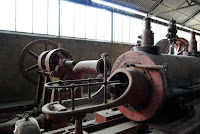 When I went home for the weekend, I visited the Louise Bourgeois exhibition at the Tate Modern. I absolutely love her work, as she has associated herself with several different artistic movements and has explored a variety of materials, so her exhibitions always offer a motley of really interesting artwork. The infamous Spider was exhibited outside the Tate Modern. The spider is a reoccuring theme, as Bourgeois believes the spider symbolises both 'a predator and a protector, a sinister threat and an industrious repairer', which according to the artist is 'an eloquent representation of the mother'. She also associates the spider, with the process of sewing, spinning and weaving, with her own mother, who ran a tapestry restoration business. Furthermore, it ties into Bourgeois' current use of fabric.
When I went home for the weekend, I visited the Louise Bourgeois exhibition at the Tate Modern. I absolutely love her work, as she has associated herself with several different artistic movements and has explored a variety of materials, so her exhibitions always offer a motley of really interesting artwork. The infamous Spider was exhibited outside the Tate Modern. The spider is a reoccuring theme, as Bourgeois believes the spider symbolises both 'a predator and a protector, a sinister threat and an industrious repairer', which according to the artist is 'an eloquent representation of the mother'. She also associates the spider, with the process of sewing, spinning and weaving, with her own mother, who ran a tapestry restoration business. Furthermore, it ties into Bourgeois' current use of fabric.Bourgeois's career spans seven decades, though there is clearly several themes, forms and motifs, which characterise her work. I was especially impressed with the scale and ambition of her environments, the cell pieces. These large installations are meant to act like tangible manifestations of psychic space. They had a confined yet reflective quality, due to the metal net around the cell, and the collection of objects, which Bourgeois displays around the installation; such as hanging chairs, mirrors, family tapestry etc.
'Cumul I'
In the early 1960s, Bourgeois created a series of sculptures made from malleable materials, such as latex and plaster, which all had the appearance of an organic matter. Later these organic sculptures went on to reveal a much more phallic or biomorphic form, which added a more obvious sexual dimension. Most of Bourgeois's sculptures were either skewed or slightly off-balance, giving them a fragile/vulnerable quality, which is rare in masculine artwork.
In Cells (Clothes), 1996, Bourgeois' themes are amplified to the point of becoming a habitable space, with circular boundaries delimited by old doors, brimming with objects, as in a warehouse of memory or an 'oneiric Wunderkammer'. The double-edged title signifies both the building block of an organism and a prison, and this installation can likewise be taken as protective or isolating. Here the work's interior could only be glimpsed through cracks in the doors, and the presence of clothing, hung on metal structures or resting on chairs, assigned the viewer the shameful role of Peeping Tom. The humble, ephemeral materials (such as clothing and underwear) and deliberately coarse items (e.g., heavy cloth) depart from the subtle refinement emphasized in certain recent marble and glass pieces.
'When I was growing up, all the women in my house were using needles. I have always had a fascination with the needle - with the magic power of the needle. The needle is used to repair the damage. It's a claim to forgiveness. It is never aggressive; it's not a pin!'








































